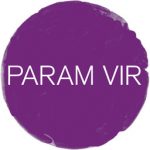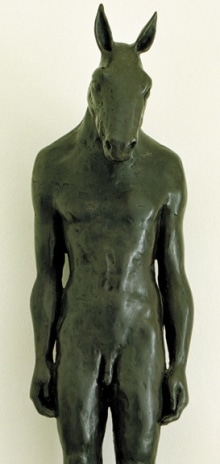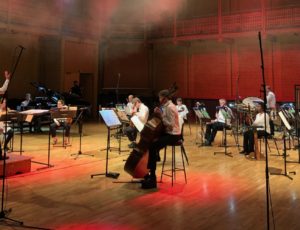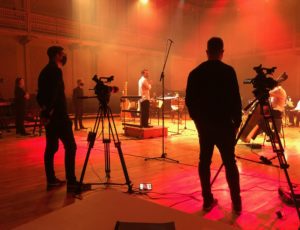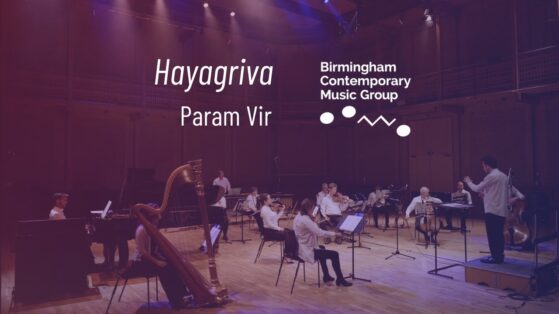Hayagriva
YEAR: 2005
ORCHESTRATION: 1(pic.afl).1(ca).1(bcl).1 / 1110 / perc / hp.pf(cel) / str[11111]
DURATION: 13′
COMMISSIONED BY: Schönberg Ensemble
DEDICATION: Micha Hamel
AVAILABILITY: Published by Novello & Co., London
PREMIERE DATE: December 13, 2005
PREMIERE INFORMATION:
Muziekgebouw aan ‘t IJ, Amsterdam
Schönberg Ensemble conducted by Micha Hamel
INTRODUCTION:
Hayagriva is a horse-headed being known in Indian and Tibetan sacred literature and art as an incarnation of Vishnu, associated with knowledge and wisdom.
WORK NOTES:
“Finally, the program featured the American premiere of Param Vir’s “Hayagriva” (horse-headed incarnation of the Indo-Tibetan deity Vishnu, who is associated with wisdom and knowledge). Vir, a Dehli-born composer now based in London, has conjured rhythms and colors vaguely reminiscent of Stravinsky’s “Rite of Spring.” His work is a stunner, with the sounds of harp, timpani, chimes, clarinet and strings all superbly rendered here. The composer was on hand for well-deserved bows, and he saluted the brilliant musicians in turn.” Hedy Weiss, Chicago Sun-Times, January 22, 2009
Listen to the work, performed by the Schoenberg Ensemble:
Schoenberg Ensemble conducted by Micha Hamel
Hayagriva is a horse-headed being known in Indian and Tibetan sacred literature and art as an incarnation of Vishnu, associated with knowledge and wisdom. He is married to another male deity Gratu, who represents inspiration and the power of intelligence. My work draws on this image of Hayagriva and continues an exploration of beings both human and non-human associated with the inner life and self-transformation.
At about the time that I began to conceive this work, I encountered the bronze ‘Standing Horse’ by Beth Carter at an art fair. It was a striking sculpture of a man with a horse’s head, and formed part of her own series of investigations of human and animal forms. My composition of the work thus drew very direct inspiration from the presence of this vibrant image in my workspace.
Though Hayagriva, as a mythological archetype, is associated with many stories and fantastical episodes, I have kept my work free of narrative and, as I did in an earlier work, internalised the drama around his magical qualities, in three distinct panels of the work. After the initial flurry of notes capped by a Tihai (rhythmic cadence appearing three times), the music settles into its first main panel, underpinned by 19 cycles of 17 beats each, organised like a chaconne with alternating harmonic fields. Images unfold at great speed and with brilliance around rhythmic re-iterations of a rhetorical gesture that mark the chaconne aurally. The piano and brass instruments are primary forces here with brilliant virtuoso passages and cadenzas, whilst the strings play almost continuously. This is very much the ‘horse-panel’, fired by the earth-colours of red and crimson, and drew some of its rhythmic energy from the following verse in the Book of Job (39:19):
Hast thou given the horse strength? hast thou clothed his neck with thunder?
Canst thou make him afraid as a grasshopper? The glory of his nostrils is terrible.
He paweth in the valley, and rejoiceth in his strength: he goeth on to meet the armed men.
He mocketh at fear, and is not affrighted; neither turneth he back from the sword.
The quiver rattleth against him, the glittering spear and the shield.
He swalloweth the ground with fierceness and rage: neither believeth he that it is the sound of the trumpet.
He saith among the trumpets, Ha, ha; and he smelleth the battle afar off, the thunder of the captains, and the shouting.
The horse panel leads to a bridging section, ‘green-gold’ in focus, associated with compassion. The chief musical elements are a duet for harp and celesta, laced with percussion. This slows down the tempo to the final panel of the work, ‘blue’, which is a single sonic space organised around a structural polyrhythm and a harmonic field based on fourths. The polyrhythmic background is symbolic of the deity Hayagriva’s association in traditional imagery with the eternity of space, and its spiral-like quality is represented by an exact golden section in the main rhythmic division of the panel. The musical objects here are sparser, fragmented, subdued, and defocused through the use of glissandi and quarter-tones; they help to undermine the identity and solidity that have characterised the first panel of the work. Through this non-narrative space is traced a melodic line in the cor anglais, canonically embellished by the viola. This leads to an epiphanic passage in other wind instruments, followed by the strings, which draw the work to its conclusion.
The work has a small tailpiece: a striking 12-note figure quoted from Parade, a very early unpublished work by Sir Peter Maxwell Davies, which I have freely re-iterated for a few bars. This codetta seemed apt as my work had its beginnings in his composition studio in Sanday, Orkney, in June 2005, when I was on a visit. Max’s work highlighted the same three primary colours in different movements (Red, Green, Blue) that I have focused in my work.
Programme Note © Param Vir, 2006
